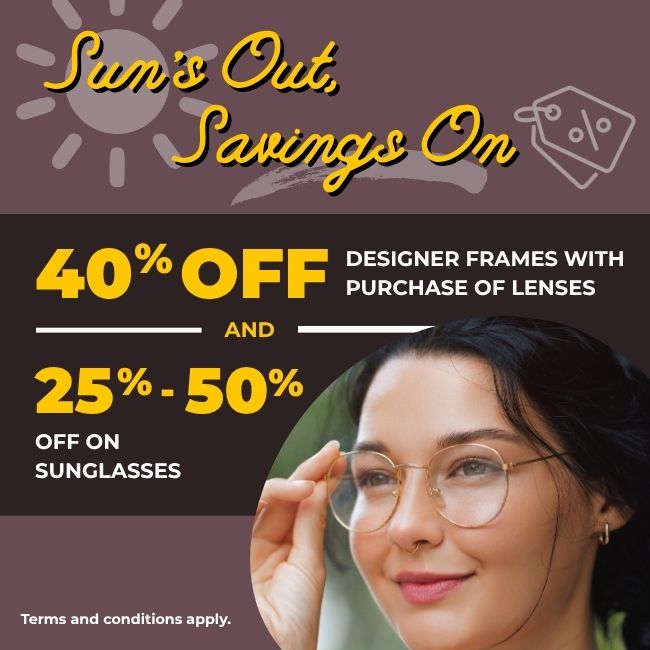
Photochromic lenses have been around since the 1960s. Popularly known as “transition lenses,” these specialized lenses adapt to different shades of light. When you’re indoors, photochromic lenses are clear—or close to it—and they darken on their own when exposed to sunlight.
Don’t confuse transition lenses with progressive lenses. Progressives contain multiple, graduated prescriptions in one lens, to help you see well at different distances.
Photochromic lenses can contain a progressive lens prescription if needed, or a bifocal or single prescription. But, they can also be non-prescription too.
Photochromic lenses are certainly convenient, but like any eyewear, they aren’t for everyone. Let’s first examine how they work, and then discuss the pros and cons of photochromic lenses.
How Do Photochromic Lenses Work?
Photochromic lenses have a light-sensitive coating on them. When exposed to the sun’s UV rays, molecules in the coating change their shape and structure, allowing them to absorb visible light and darken.
Even when the sun isn’t shining, photochromic lenses might darken because UV rays penetrate cloud cover. But, they don’t always darken to their final sunglass form during high-glare activities like boating or skiing. So if you’re someone who is light-sensitive, they might not be the right option for your eyes.
Some people swear by their photochromic lenses. If you’re wondering if they’re right for you, read on:
Pros of Photochromic Lenses
UV Protection
UV rays can do plenty of damage. Between 5% and 10% of skin cancer is eyelid skin cancer. Other types of cancer near the eye can also occur from too much sun exposure. Without UV protection, your risk of other eye diseases increases too.
Photochromic lenses almost always have UV protection to shield your eyes from the sun’s rays.
Endless Options
Years ago, photochromic lenses were only available in grey. Now, they come in colours like ambers, browns, and greens too. Sleek classic lines, trendy cat-eye frames, or the always-cool aviator style can contain photochromic lenses.
So, whatever fashion statement you want to make, you can do it with photochromic eyewear. The lenses are also available in prescription or non-prescription varieties. If you need bifocals, trifocals, or progressive lenses, you can get them in photochromic varieties too.
Convenience
For prescription eyewear users, carrying glasses and sunglasses wherever you go and scrambling to switch between them is a familiar event. Photochromic lenses make it possible to have a two-in-one solution.
If you’re someone who misplaces your glasses regularly or forgets your sunglasses at home, it can be a lifesaver to have just one pair of eyewear to keep track of. With photochromic lenses, you won’t need that second set of specs to search for.
Cost Savings
A single pair of eyewear is great if you’re on a budget. Photochromic lenses might save you from having to invest in a pair of prescription sunglasses. You can just have a single piece of eyewear for all sun conditions.
When it comes time to replace your eyewear or update your prescription, you’ll just be replacing one pair, not sunglasses and regular glasses at the same time.

Cons of Photochromic Lenses
Temperature Fluctuations
The temperature impacts the rapidity of shade changes in photochromic lenses. During extreme heat, they may not achieve full darkness and in colder temperatures, they might take extra time to return to a clear state.
Molecules move slower in the cold so the delay in shade shift during winter weather is due to the slower shape-changing of the coating’s molecules.
Reaction Times
Photochromic lenses adjust to your surroundings relatively quickly, though the slight delay can be bothersome. The time it takes lenses to change shade depends on temperature, brand, age, and amount of UV exposure.
Normally, it takes the lenses about 30 seconds to darken and 5 minutes or less to return to their clear state once indoors. If you go back and forth between outdoor and indoor environments throughout the day and require rapid change, photochromic lenses might not be for you.
Difficulty Driving
The windshield of your car can block the UV light needed to begin the chemical process that changes the shade of your photochromic lenses. So, while you can certainly drive in them, they might not help limit sunlight while you do so.
Wear & Tear
Over time, photochromic lenses become less effective. They generally last around 3 years before they lose their ability to darken when exposed to UV light.
So, Should I Get Photochromic Lenses?
As with any eyewear decision, it’s important to talk with your optometrist about the options. They’ll discuss your lifestyle and needs with you and help you select the choice for your unique situation.



